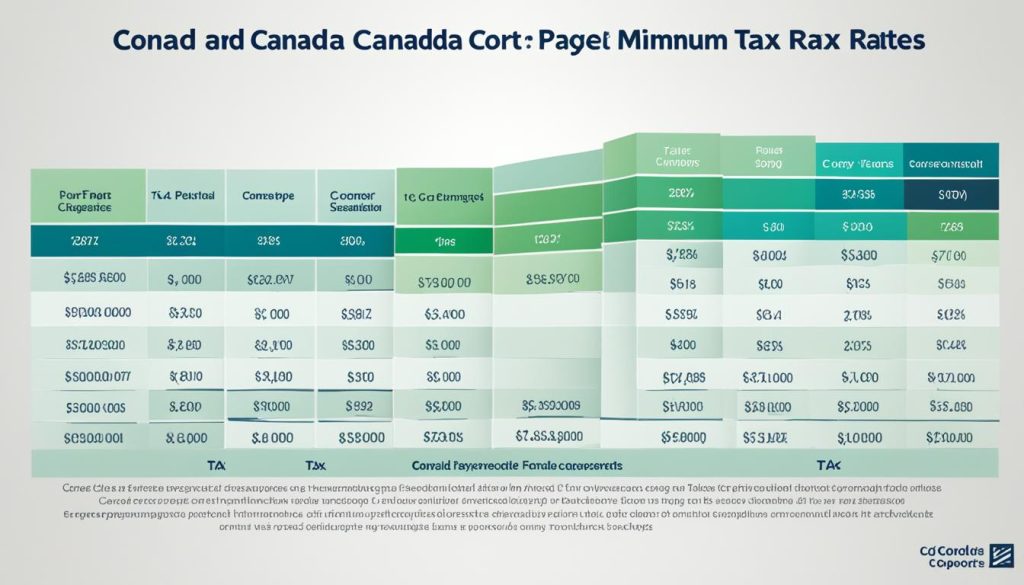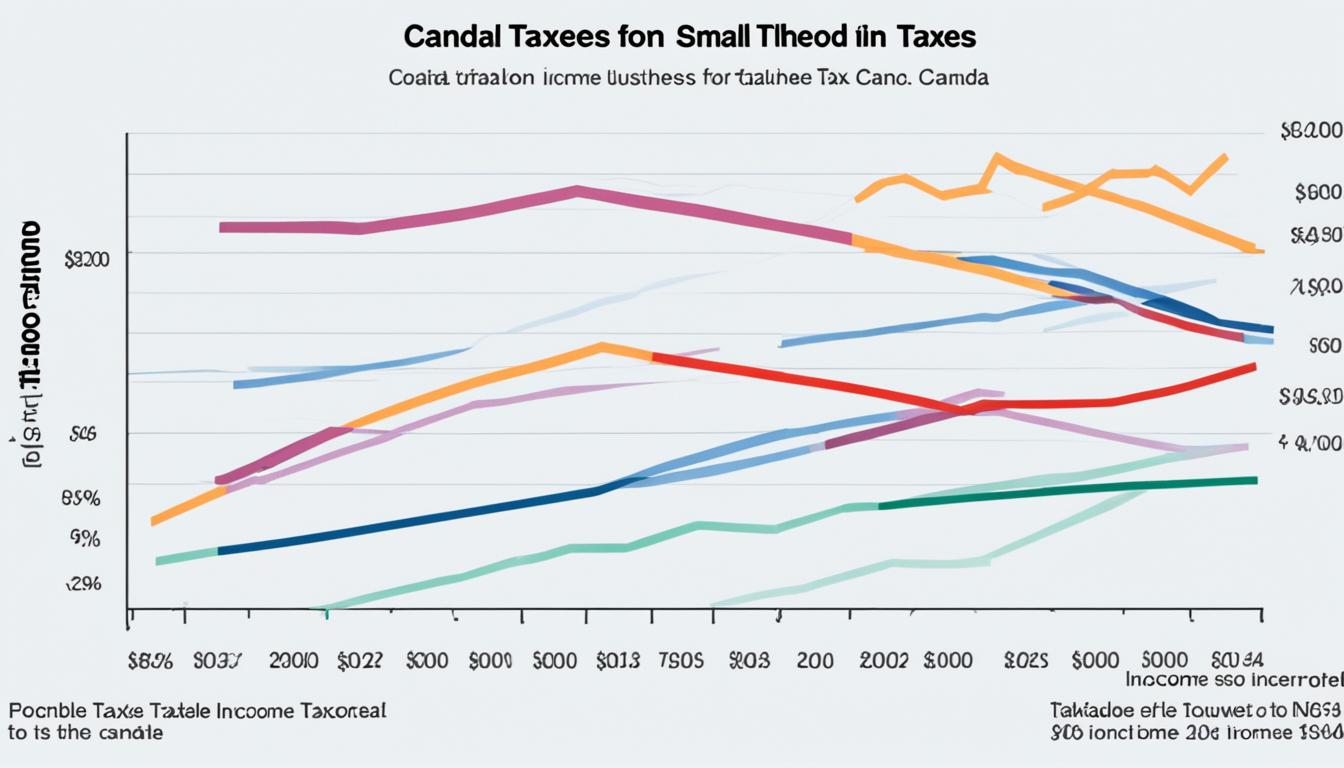Did you know that a staggering 97.9% of all businesses in Canada are considered small enterprises? Yet, the tax landscape for these small businesses can be surprisingly complex. As a small business owner in Canada, it’s crucial to understand how much you can earn before having to pay taxes. This article will dive deep into the intricacies of small business taxation, helping you navigate the system and minimize your tax obligations.
From defining what qualifies as a small business for tax purposes to uncovering the criteria for the Small Business Deduction (SBD), we’ll cover it all. You’ll learn about the federal and provincial/territorial corporate tax rates, discover how to calculate your small business tax rate and explore the various tax credits and deductions available to you. By the end of this comprehensive guide, you’ll have a clear understanding of the tax implications for your small business in Canada.
Defining a Small Business for Tax Purposes in Canada
To be considered a small business for tax purposes in Canada, the business must meet the definition of a Canadian-Controlled Private Corporation (CCPC). A CCPC is a private corporation that is controlled by Canadian residents and is not publicly traded. This means the business must be majority-owned by Canadian citizens or permanent residents, and its shares cannot be publicly traded on a stock exchange.
In addition to being a CCPC, the business must also generate active business income, rather than passive investment income. Active business income refers to revenue generated from the regular operations of the business, such as selling goods or providing services. Passive income, on the other hand, includes investment earnings like interest, dividends, and capital gains.
Finally, the business must not be classified as a Personal Service Business (PSB). A PSB is an incorporated business where the individual provides services to a business in a way that should be considered a regular salaried employee. If the business is deemed a PSB, it will not be eligible for the small business tax rates and deductions.
By meeting these criteria, a small business in Canada can take advantage of the reduced federal and provincial/territorial tax rates and various tax credits and deductions available to small businesses. Understanding these definitions is crucial for ensuring compliance with the Canada Revenue Agency’s (CRA) requirements for small business taxation, including when to start charging GST and at what value of sales the business must register with the CRA.

Small Business Deduction (SBD) Criteria
To qualify for the Small Business Deduction (SBD) in Canada, a business must meet three key criteria. Firstly, the business must earn less than $50,000 in passive investment income. This threshold is in place to ensure that businesses are primarily focused on active business operations, rather than passive investment activities.
Secondly, the business must earn less than $500,000 in active business income during the taxation year. This limit helps to target the SBD towards smaller businesses, as opposed to larger corporations. Finally, the business’s taxable capital must be less than $10 million.
By meeting these criteria, the business can benefit from the reduced federal small business tax rate of 9%, compared to the general corporate tax rate of 15%. This can result in significant tax savings for small businesses in Canada, especially those operating in Ontario where the combined federal and provincial small business tax rate is just 12.2%. Staying within these thresholds is crucial for small businesses to maximize their tax efficiency and retain more of their hard-earned profits.
1. Passive Investment Income Limit
The $50,000 passive investment income limit is an important consideration for small businesses in Canada. If a business earns more than $50,000 in passive investment income during the taxation year, it will no longer qualify for the SBD. This rule is in place to ensure that the tax benefits of the SBD are targeted towards businesses that are actively engaged in generating revenue, rather than those that are primarily focused on investment activities.
2. Active Business Income Limit
The $500,000 active business income limit is another key criterion for the SBD. Businesses that earn more than $500,000 in active business income during the taxation year will not be eligible for the reduced 9% federal small business tax rate. This threshold helps to differentiate small businesses from larger corporations, ensuring that the tax benefits are directed towards companies that are truly small in scale.
3. Taxable Capital Limit
The third and final criterion for the SBD is the $10 million taxable capital limit. If a business’s taxable capital exceeds this threshold, it will not be eligible for the reduced small business tax rate. This rule is in place to prevent larger, more established businesses from benefiting from the tax advantages intended for smaller enterprises.
By understanding and adhering to these three key criteria, small businesses in Canada can ensure that they qualify for the valuable Small Business Deduction and minimize their tax obligations.
Federal Corporate Tax Rates
In Canada, there are two main federal corporate tax rates that small businesses need to be aware of. Businesses that qualify as a Canadian-Controlled Private Corporation (CCPC) and meet the Small Business Deduction (SBD) criteria pay a reduced federal small business tax rate of 9%. This lower tax rate allows small businesses in Canada to retain more of their earnings for reinvestment and growth.
CCPC Small Business Rate
To take advantage of the 9% federal small business tax rate, a company must be classified as a CCPC and satisfy the SBD requirements, such as having less than $500,000 in active business income and less than $50,000 in passive investment income during the taxation year. Meeting these criteria enables small businesses in Canada to benefit from the small business tax exemption and canadian small business income tax threshold at the federal level.
Corporate Tax Rate
Businesses that do not qualify for the SBD, as well as larger corporations, pay the general federal corporate tax rate of 15%. This higher rate applies after accounting for the 10% federal tax abatement and 13% general tax reduction. Understanding the differences between the CCPC small business rate and the general corporate tax rate is crucial for small businesses in Canada to accurately calculate and plan for their federal tax obligations.

Provincial and Territorial Corporate Tax Rates
In addition to the federal corporate tax rates, small businesses in Canada must also pay provincial or territorial corporate tax on their revenue. The tax-free income for small businesses in canada can vary significantly depending on the location of the business. Most provinces use the federal small business deduction threshold of $500,000 for small business tax deductions canada.
The canadian tax rules for small enterprises include small business tax rates ranging from 0% in Saskatchewan and Yukon to 3.2% in Ontario. The general corporate tax rates across the provinces and territories vary from 8% in Alberta to 16% in Prince Edward Island.
| Province/Territory | Small Business Tax Rate | General Corporate Tax Rate |
|---|---|---|
| Alberta | 2% | 8% |
| British Columbia | 2% | 12% |
| Manitoba | 0% | 12% |
| New Brunswick | 2.5% | 14% |
| Newfoundland and Labrador | 3% | 15% |
| Northwest Territories | 2% | 11.5% |
| Nova Scotia | 3.5% | 16% |
| Nunavut | 3% | 12% |
| Ontario | 3.2% | 11.5% |
| Prince Edward Island | 1% | 16% |
| Quebec | 3.2% | 11.5% |
| Saskatchewan | 0% | 12% |
| Yukon | 0% | 12% |
This comprehensive overview of the provincial and territorial corporate tax rates in Canada highlights the importance for small businesses to understand the canadian tax rules for small enterprises applicable to their specific location. By optimizing their tax planning strategies, small businesses can maximize their tax-free income for small businesses in canada and leverage available small business tax deductions canada.
Calculating Your Small Business Tax Rate
As a small business owner in Canada, understanding how to calculate your tax rate is crucial for effective small business tax planning. This process involves three key steps: determining your CCPC eligibility, identifying your active business income, and applying the small business deduction.
1. Determining CCPC Eligibility
The first step in calculating your small business tax rate is to ensure your business qualifies as a Canadian-Controlled Private Corporation (CCPC). This designation is essential to take advantage of the reduced federal small business tax rate of 9%. To be considered a CCPC, your business must be privately held and controlled by Canadian residents, and it cannot be publicly traded.
2. Identifying Active Business Income
Once you’ve established your CCPC status, you’ll need to determine whether your business income qualifies as active business income or passive investment income. Active business income, which is eligible for the small business deduction, includes revenue from the sale of goods or services. In contrast, passive investment income, such as interest, dividends, and rental income, is not eligible for the deduction.
3. Applying the Small Business Deduction
The final step is to verify that your taxable income is within the $500,000 small business deduction limit. If your business meets all the criteria – CCPC status, active business income, and taxable income below the deduction threshold – you can apply the 9% federal small business tax rate, along with the applicable provincial or territorial rate, to calculate your combined small business tax rate. Leveraging tax breaks for startups and small business tax credits can further reduce your overall tax burden.

How Much Can a Small Business Make Before Paying Taxes in Canada?
When it comes to how much can a small business make before paying taxes in Canada, the answer is not as straightforward as a specific gross income threshold. The key factor is the business’s net income, not the gross revenue. Any positive net income, no matter how small, will be subject to taxes in Canada.
If a small business in Canada has a net loss for the year, it will not have to pay any taxes. However, once the business starts generating positive net income, even if it’s a modest amount, that income will be taxable. The how much can a small business make before paying taxes in Canada ultimately depends on the business’s overall profitability and net earnings, rather than a predetermined gross revenue limit.
It’s important for small business owners in Canada to understand that there is no minimum threshold where they can avoid paying taxes altogether. Careful tax planning and maximizing available deductions and credits are crucial to minimize the overall tax burden for a small business in Canada.

Tax Deadlines and Filing Requirements
In Canada, small businesses must be aware of the tax deadlines and filing requirements to remain compliant and avoid penalties. These businesses are required to file their corporate tax returns and pay any taxes owed within six months of the end of their fiscal year. It’s important to note that the tax year is based on the business’s fiscal year, not the calendar year.
For example, if a small business’s fiscal year ends on March 31, their tax year would end on September 30, and their tax return would be due by the following March 31. This means that who doesn’t have to pay taxes in canada? must still file their tax returns and pay any applicable taxes, regardless of their income level.
Staying up-to-date with these tax deadlines and filing requirements is crucial for small businesses in Canada. Failure to do so can result in penalties and potential legal issues. By understanding and adhering to these guidelines, small business owners can ensure they remain in good standing with the Canada Revenue Agency (CRA) and avoid unnecessary financial burdens.
Small Business Tax Credits and Deductions
Small businesses in Canada can take advantage of various tax credits and deductions to minimize their tax obligations. These include investment tax credits, environmental tax credits, the Capital Cost Allowance (CCA), input tax credits, and hiring credits. Leveraging these tax-saving opportunities can help small businesses reduce their overall tax burden.
1. Investment Tax Credits
Businesses can claim investment tax credits for their scientific research and experimental development (SR&ED) activities. These credits can help offset the costs of innovating and developing new products or processes, ultimately reducing the small business tax credits canada.
2. Environmental Tax Credits
Canada also offers tax credits for businesses that implement sustainable practices, such as investing in renewable energy or energy-efficient technologies. These small business tax write-offs canada can incentivize small businesses to adopt more environmentally-friendly operations.
3. Capital Cost Allowance (CCA)
The CCA allows small businesses to claim deductions for the depreciation of their capital assets, such as equipment, machinery, and vehicles. This can significantly reduce the taxable income and, in turn, the overall tax liability.
4. Input Tax Credits
Businesses can claim input tax credits for the Goods and Services Tax (GST) or Harmonized Sales Tax (HST) paid on eligible business expenses. This helps small businesses offset the cost of the taxes they incur while operating their company.
5. Hiring Credits
The Canadian government offers various hiring credits and incentives to encourage small businesses to expand their workforce. These credits can provide valuable tax savings for businesses that create new jobs or hire individuals from targeted groups.
| Tax Credit or Deduction | Description | Potential Benefits for Small Businesses |
|---|---|---|
| Investment Tax Credit (SR&ED) | Tax credit for research and development activities | Offsets the costs of innovating and developing new products or processes |
| Environmental Tax Credits | Tax credits for sustainable business practices, such as investing in renewable energy | Encourages the adoption of environmentally-friendly operations |
| Capital Cost Allowance (CCA) | Deduction for the depreciation of capital assets | Reduces the taxable income and overall tax liability |
| Input Tax Credits | Credits for the GST/HST paid on eligible business expenses | Offsets the cost of taxes incurred while operating the business |
| Hiring Credits | Incentives for creating new jobs or hiring from targeted groups | Provides valuable tax savings for expanding the workforce |
Harmonized Sales Tax (HST) and Goods and Services Tax (GST)
In addition to corporate income taxes, small businesses in Canada may also be required to collect and remit the Harmonized Sales Tax (HST) or Goods and Services Tax (GST), depending on their revenue levels. Businesses that generate $30,000 or more in revenue for four consecutive quarters must register for and charge HST/GST on their sales. Understanding the HST/GST thresholds and requirements is crucial for small businesses to remain compliant.
The value of sales that triggers the requirement to register with the Canada Revenue Agency (CRA) for HST/GST is $30,000 in a four-quarter period. This means that once a small business reaches this revenue threshold, it must start charging and collecting the applicable GST or HST on its sales. Failure to register and comply with these sales tax obligations can result in penalties and interest charges from the CRA.
It’s important for small business owners to be aware of when they need to start charging GST on their products or services. The general rule is that once a business’s annual sales exceed $30,000, they must register for and collect the GST or HST. Businesses that make less than $30,000 in a year are not required to charge or collect the GST or HST, but they can still choose to register voluntarily.
| Requirement | Threshold |
|---|---|
| HST/GST Registration | $30,000 in revenue over 4 consecutive quarters |
| Charging HST/GST | $30,000 in annual revenue |
By understanding the HST/GST thresholds and requirements, small business owners in Canada can ensure they are compliant with the applicable sales tax regulations and avoid any potential issues or penalties from the CRA.
Additional Taxes for Small Businesses
While corporate income taxes and sales taxes are the primary tax obligations for small businesses in Canada, there are also other taxes that they may need to consider. These additional taxes can have a significant impact on a small business’s overall tax burden and should be factored into the company’s tax planning strategy.
1. Payroll Taxes
Payroll taxes are mandatory contributions that employers must make on behalf of their employees. These include contributions to programs like the Canada Pension Plan (CPP) and Employment Insurance (EI). Employers must withhold a portion of their employees’ earnings and remit these payroll taxes to the Canada Revenue Agency (CRA). The amount of payroll taxes owed depends on the number of employees, their salaries, and the applicable contribution rates, which can vary based on the province or territory.
2. Carbon Taxes
In addition to payroll taxes, small businesses in Canada may also be subject to carbon taxes. Carbon taxes are levied on the consumption of goods and services that produce greenhouse gas emissions, such as the use of gasoline or natural gas. The carbon tax rate is determined by the province or territory, and it is designed to encourage businesses and individuals to reduce their carbon footprint and adopt more environmentally-friendly practices. Small businesses must factor in these carbon tax obligations when calculating their overall tax liability.
Understanding the various tax obligations, including payroll taxes and carbon taxes, is crucial for small businesses in Canada to ensure compliance and minimize their overall tax burden. Effective tax planning can help small businesses optimize their financial operations and allocate resources more effectively.
Conclusion
Throughout this comprehensive article, we’ve delved into the intricate world of small business taxation in Canada. From defining a small business for tax purposes to navigating the criteria for the Small Business Deduction, understanding federal and provincial/territorial corporate tax rates, and exploring the available tax credits and deductions, we’ve covered a vast array of essential information to empower small business owners in Canada.
By familiarizing themselves with these key concepts, small business owners can better navigate the tax landscape, minimize their tax obligations, and ensure compliance with all relevant regulations. This knowledge equips them to make informed decisions, optimize their tax strategies, and ultimately focus on the growth and success of their enterprises.
As the Canadian economy continues to evolve, it’s crucial for small businesses to stay abreast of the latest tax developments and leverage the available tax-saving opportunities. By doing so, they can not only minimize their tax burden but also reinvest those resources into the expansion and innovation that drive their businesses forward.
FAQ
1. What qualifies as a small business in Canada?
To be considered a small business for tax purposes in Canada, the business must meet the definition of a Canadian-Controlled Private Corporation (CCPC). This means the business must be a private corporation controlled by Canadian residents and not publicly traded. The business must also generate active business income rather than passive investment income and not be classified as a Personal Service Business (PSB).
2. What are the criteria for the Small Business Deduction (SBD) in Canada?
To qualify for the Small Business Deduction (SBD) in Canada, a business must meet three key criteria: 1) the business earns less than $50,000 in passive investment income, 2) the business earns less than $500,000 in active business income during the taxation year, and 3) the business’s taxable capital is less than $10 million.
3. What are the federal corporate tax rates in Canada?
In Canada, there are two main federal corporate tax rates. Businesses that qualify as a CCPC and meet the SBD criteria pay a reduced federal small business tax rate of 9%. Businesses that do not qualify for the SBD, as well as larger corporations, pay the general federal corporate tax rate of 15%.
4. What are the provincial and territorial corporate tax rates in Canada?
The provincial/territorial tax rates vary across the country, with most provinces using the federal small business deduction threshold of $500,000 for active income earned. The small business tax rates range from 0% in Saskatchewan and Yukon to 3.2% in Ontario, with the general corporate tax rates ranging from 8% in Alberta to 16% in Prince Edward Island.
5. How do I calculate my small business tax rate in Canada?
To calculate your small business tax rate in Canada, you must first determine if your business qualifies as a CCPC by checking the eligibility rules. Next, you need to ensure your business income qualifies as active business income, not passive investment income. Finally, you need to verify that your taxable income is within the small business deduction limit of $500,000. If your business meets all the criteria, you can apply the 9% federal small business tax rate, along with the applicable provincial/territorial rate, to calculate your combined small business tax rate.
6. How much can a small business make before paying taxes in Canada?
There is no minimum threshold where a small business in Canada does not have to pay taxes. The key factor is the business’s net income, not the gross income. Any positive net income will be subject to taxes, even if it is a small amount. If the business has a loss, it will not have to pay tax. Therefore, the amount a small business can make before paying taxes in Canada depends more on the net income than a specific gross income threshold.
7. When do small businesses in Canada need to file their taxes?
Small businesses in Canada must file their corporate tax returns and pay any taxes owed within six months of the end of their fiscal year. The tax year is based on the business’s fiscal year, not the calendar year.
8. What tax credits and deductions are available for small businesses in Canada?
Small businesses in Canada can take advantage of various tax credits and deductions to minimize their tax obligations, including investment tax credits, environmental tax credits, the Capital Cost Allowance (CCA), input tax credits, and hiring credits.
9. Do small businesses in Canada have to collect and remit the Harmonized Sales Tax (HST) or Goods and Services Tax (GST)?
Businesses that generate $30,000 or more in revenue for four consecutive quarters must register for and charge HST/GST on their sales. Understanding the HST/GST thresholds and requirements is crucial for small businesses to remain compliant.
10. What other taxes do small businesses in Canada need to pay?
In addition to corporate income taxes and sales taxes, small businesses in Canada may also be subject to other taxes, such as payroll taxes and carbon taxes. Payroll taxes include contributions to programs like the Canada Pension Plan (CPP) and Employment Insurance (EI), which employers must remit on behalf of their employees. Carbon taxes are paid by businesses that consume goods and services subject to carbon pricing, such as gasoline.




